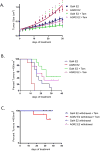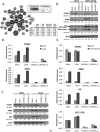Delineation of a FOXA1/ERα/AGR2 regulatory loop that is dysregulated in endocrine therapy-resistant breast cancer
- PMID: 25100862
- PMCID: PMC4272635
- DOI: 10.1158/1541-7786.MCR-14-0195
Delineation of a FOXA1/ERα/AGR2 regulatory loop that is dysregulated in endocrine therapy-resistant breast cancer
Abstract
Tamoxifen, a selective estrogen receptor (ER) modulator (SERM), remains a frontline clinical therapy for patients with ERα-positive breast cancer. However, the relatively rapid development of resistance to this drug in the metastatic setting remains an impediment to a durable response. Although drug resistance likely arises by many different mechanisms, the consensus is that most of the implicated pathways facilitate the outgrowth of a subpopulation of cancer cells that can either recognize tamoxifen as an agonist or bypass the regulatory control of ERα. Notable in this regard is the observation here and in other studies that expression of anterior gradient homology 2 (AGR2), a known proto-oncogene and disulfide isomerase, was induced by both estrogen (17β-estradiol, E2) and 4-hydroxytamoxifen (4OHT) in breast cancer cells. The importance of AGR2 expression is highlighted here by the observation that (i) its knockdown inhibited the growth of both tamoxifen-sensitive and -resistant breast cancer cells and (ii) its increased expression enhanced the growth of ERα-positive tumors in vivo and increased the migratory capacity of breast cancer cells in vitro. Interestingly, as with most ERα target genes, the expression of AGR2 in all breast cancer cells examined requires the transcription factor FOXA1. However, in tamoxifen-resistant cells, the expression of AGR2 occurs in a constitutive manner, requiring FOXA1, but loses its dependence on ER. Taken together, these data define the importance of AGR2 in breast cancer cell growth and highlight a mechanism where changes in FOXA1 activity obviate the need for ER in the regulation of this gene.
Implications: These findings reveal the transcriptional interplay between FOXA1 and ERα in controlling AGR2 during the transition from therapy-sensitive to -resistant breast cancer and implicate AGR2 as a relevant therapeutic target.
©2014 American Association for Cancer Research.
Figures





Similar articles
-
Down-regulation of Forkhead box protein A1 (FOXA1) leads to cancer stem cell-like properties in tamoxifen-resistant breast cancer cells through induction of interleukin-6.J Biol Chem. 2017 May 19;292(20):8136-8148. doi: 10.1074/jbc.M116.763276. Epub 2017 Mar 7. J Biol Chem. 2017. PMID: 28270510 Free PMC article.
-
Anterior gradient-2 plays a critical role in breast cancer cell growth and survival by modulating cyclin D1, estrogen receptor-alpha and survivin.Breast Cancer Res. 2010;12(3):R32. doi: 10.1186/bcr2586. Epub 2010 Jun 4. Breast Cancer Res. 2010. PMID: 20525379 Free PMC article.
-
Binding of anterior gradient 2 and estrogen receptor-α: Dual critical roles in enhancing fulvestrant resistance and IGF-1-induced tumorigenesis of breast cancer.Cancer Lett. 2016 Jul 10;377(1):32-43. doi: 10.1016/j.canlet.2016.04.003. Epub 2016 Apr 7. Cancer Lett. 2016. PMID: 27063095
-
The estrogen-regulated anterior gradient 2 (AGR2) protein in breast cancer: a potential drug target and biomarker.Breast Cancer Res. 2013 Apr 24;15(2):204. doi: 10.1186/bcr3408. Breast Cancer Res. 2013. PMID: 23635006 Free PMC article. Review.
-
The Divergent Effects of Ovarian Steroid Hormones in the MCF-7 Model for Luminal A Breast Cancer: Mechanistic Leads for Therapy.Int J Mol Sci. 2022 Apr 27;23(9):4800. doi: 10.3390/ijms23094800. Int J Mol Sci. 2022. PMID: 35563193 Free PMC article. Review.
Cited by
-
Robust identification of target genes and outliers in triple-negative breast cancer data.Stat Methods Med Res. 2019 Oct-Nov;28(10-11):3042-3056. doi: 10.1177/0962280218794722. Epub 2018 Aug 27. Stat Methods Med Res. 2019. PMID: 30146936 Free PMC article.
-
Association of increased primary breast tumor AGR2 with decreased disease-specific survival.Oncotarget. 2018 May 1;9(33):23114-23125. doi: 10.18632/oncotarget.25225. eCollection 2018 May 1. Oncotarget. 2018. PMID: 29796176 Free PMC article.
-
Time-varying effects of FOXA1 on breast cancer prognosis.Breast Cancer Res Treat. 2021 Jun;187(3):867-875. doi: 10.1007/s10549-021-06125-7. Epub 2021 Feb 18. Breast Cancer Res Treat. 2021. PMID: 33604715
-
Integrated molecular analysis of Tamoxifen-resistant invasive lobular breast cancer cells identifies MAPK and GRM/mGluR signaling as therapeutic vulnerabilities.Mol Cell Endocrinol. 2018 Aug 15;471:105-117. doi: 10.1016/j.mce.2017.09.024. Epub 2017 Sep 19. Mol Cell Endocrinol. 2018. PMID: 28935545 Free PMC article.
-
The Central Contributions of Breast Cancer Stem Cells in Developing Resistance to Endocrine Therapy in Estrogen Receptor (ER)-Positive Breast Cancer.Cancers (Basel). 2019 Jul 22;11(7):1028. doi: 10.3390/cancers11071028. Cancers (Basel). 2019. PMID: 31336602 Free PMC article. Review.
References
-
- American Cancer Society. Facts and Figures. 2013 Available from: http://www.cancer.org/acs/groups/content/@epidemiologysurveilance/docume....
-
- Arpino G, De Angelis C, Giuliano M, Giordano A, Falato C, De Laurentiis M, et al. Molecular mechanism and clinical implications of endocrine therapy resistance in breast cancer. Oncology. 2009;77(Suppl 1):23–37. - PubMed
-
- Berstein LM, Zheng H, Yue W, Wang JP, Lykkesfeldt AE, Naftolin F, et al. New approaches to the understanding of tamoxifen action and resistance. Endocrine-related cancer. 2003;10:267–77. - PubMed
-
- Hurvitz SA, Pietras RJ. Rational management of endocrine resistance in breast cancer: a comprehensive review of estrogen receptor biology, treatment options, and future directions. Cancer. 2008;113:2385–97. - PubMed
-
- Ma XJ, Hilsenbeck SG, Wang W, Ding L, Sgroi DC, Bender RA, et al. The HOXB13:IL17BR expression index is a prognostic factor in early-stage breast cancer. Journal of clinical oncology : official journal of the American Society of Clinical Oncology. 2006;24:4611–9. - PubMed
Publication types
MeSH terms
Substances
Grants and funding
LinkOut - more resources
Full Text Sources
Other Literature Sources
Medical
Miscellaneous

